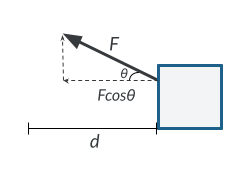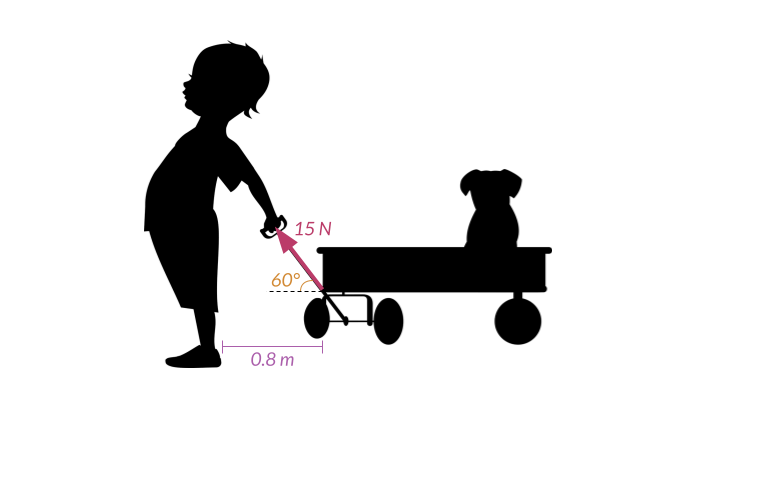| The Work Equation: Explanation and Examples | 您所在的位置:网站首页 › powerequation › The Work Equation: Explanation and Examples |
The Work Equation: Explanation and Examples
|
Work and power are everyday terms that have special meanings in physics. This post will cover the work equation, how to calculate work, and the relationship between work and power. Interested in an Albert school license?What We Review The Work Equation The Definition of WorkIn physics, work is defined as the change of energy in a system caused by a force applied over a displacement. When a force acting on an object causes the object to move, we say that work is done on the object. For example, the dogs in the picture below are doing work on the sled because they are applying a force that pulls the sled forward. 
It’s important to know that in order for work to be done, the force must cause displacement and move the object. If you push as hard as you can on a building, you may get exhausted from the force you apply but you’re not actually doing work because the building doesn’t move. When is Work Positive or Negative?Work can be either positive or negative depending on the direction of the force relative to the direction of the displacement. Work is positive when the force and displacement are in the same direction. The dogs in the previous example are doing positive work on the sled because the slide is moving in the same direction as the force the dogs are applying by pulling forward. Work is negative when the force and displacement are in opposite directions. A common force that typically does negative work is friction. For example, when a baseball player slides toward home plate, the force of friction from the ground opposes his motion and the work done by friction on the baseball player is negative. Check out this video from GPB Education for more examples of work and how it can be positive or negative. Interested in an Albert school license? The Equation for WorkWe can calculate work using the following equation: The Work EquationW=F \cdot d…where: W is work F is force d is displacement How to Calculate Work Using the EquationBased on the equation above, you can calculate work by multiplying force and displacement. For example, if a person exerts a 5\text{ N} force that pushes a box 2\text{ m}, then the work done on the box will be 5\text{ N} \cdot 2\text{ m} or 10\text{ Nm}. Work can also be measured in units of Joules. One Joule is defined as the work done by 1 newton of force acting over 1 meter of displacement. So the person does 10\text{ J} of work on the box. Using the equation for work is a bit more complicated in situations where the force is applied at an angle relative to the displacement. You will need to first determine the component of the force in the same direction as the displacement. For example, consider a box moving to the left pulled by a force at an angle as shown below. 
In this situation, only the horizontal component of the force is causing the displacement of the box to the left. For situations like this where the force is applied at an angle, you can use the following equation to calculate work: The Work Equation for Forces at an AngleW=Fd\cos\theta…where: W is work F is force d is displacement \theta is the angle between the force and displacement Explore Work on Albert Work and PowerSo far we’ve shown how work is done when a force is applied over a displacement. Sometimes it’s important to measure how quickly or slowly that work is done. This is where power comes in. The Relationship Between Work and Power
Since work only depends on force and displacement, the amount of time it takes to complete the action has no impact on the amount of work done. For example, say Ben and Jerry are each carrying a 200\text{ N} box up the same flight of stairs of 3\text{ m}, but Ben takes 60\text{ s} to get to the top while Jerry races up in only 15\text{ s}. Both are exerting the same force and climbing the same displacement, so they are doing the same amount of work of 600\text{ J}, even though Jerry is clearly in better shape. Power gives us a way to consider the amount of time it takes to do that work. Power is the rate at which work is done. So when Jerry climbs the stairs in less time, we can say that he has more power than Ben because he did the same amount of work at a faster rate. Interested in an Albert school license? How to Calculate PowerWe can calculate power using the following equation: The Power EquationP=\dfrac{W}{t}…where: P is power W is work t is timeWhen using this equation, the standard units for power are Watts or W. If you have already determined the amount of work done, power is calculated by simply dividing that work by time. If we return to our friends Ben and Jerry, we already know that both did 600\text{ J} of work. Ben did this work in 60\text{ s}, so his power is \frac{600\text{ J}}{60\text{ s}} or 10\text{ W}. Whereas Jerry’s power is \frac{600\text{ J}}{15\text{ s}} or 40\text{ W}. Explore Power on Albert The Difference Between Work and Power Applying the Work Equation Tips and Strategies for Using the Work EquationWhen substituting values for force and displacement, you’ll want to make sure you use the right sign based on their direction. For example, if the force and displacement have the same direction, both values will have the same sign so their product, the work, will be positive. However, if the force is opposing the displacement, make sure you use a negative value for the force so that you get a result of negative work. Another tip for using the work equation is to pay careful attention to the force that is causing the displacement. If the force is applied at an angle to the displacement, you will need to first determine the component of the force that is parallel to the displacement or use the more general work equation of W=Fd\cos\theta. In this situation, remember that the angle \theta is specifically the angle between the force and displacement vectors. Need to review common problem-solving strategies? Revisit our blog post on kinematic equations for tips on breaking down and completing physics word problems. Interested in an Albert school license? Examples of Calculating Work and Power Example: Work and Power for a WeightlifterA weightlifter lifts a 1500\text{ N} weight 1.7\text{ m} in 2\text{ s}. What is the weightlifter’s power output? Before we can calculate the power, we must first determine the work the weightlifter does. The force the weightlifter applies is 1500\text{ N} and the displacement is 1.7\text{ m}. Therefore the work done is: W=F \cdot d W=(1500\text{ N})(1.7\text{ m}) W=2550\text{ J} In this situation, the work is positive because the force and displacement are both in the upward direction. Next, we will substitute this work along with the time of 2\text{ s} into the equation for power: P=\dfrac{W}{t} P=\dfrac{2550\text{ J}}{2\text{ s}} P=1275\text{ W} Example 2: Work Pulling a WagonA child pulls a wagon with a force of 15\text{ N} at an angle of 60^{\circ} and displaces the wagon 0.8\text{ m}. How much work is done on the wagon? 
To calculate the work done on the wagon, we will apply the work equation: W=Fd\cos\theta In this scenario the force, F, is 15\text{ N} and the displacement, d, is 0.8\text{ m}. The angle, \theta, between the force and the displacement is 60^{\circ}. Substituting these values into the work equation produces: W=(15\text{ N})(0.8\text{ m})\cos(60^{\circ}) W=6\text{ J} The child does 6\text{ J} of work on the wagon. The work done is positive because the horizontal component of the force and the displacement are in the same direction. Explore Work and Power on Albert ConclusionNow you know more about the specific meanings of work and power in physics. Work is done whenever a force is applied through a displacement and power is the rate of change of work. In our next article, you’ll learn how work is also closely related to energy and how to use that relationship to solve physics problems. |
【本文地址】